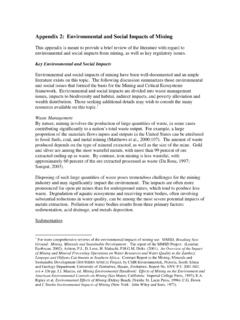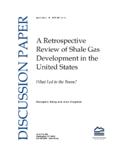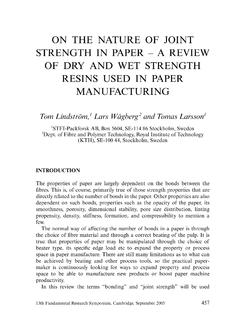Transcription of Pollutants from the EU Watch List: a review of their ...
1 Micropollutants small, persistent and biologically active substances are found in aquatic environments all over the world and can have negative effects on plants, animals and humans. The EU recently adopted a Watch list of potential priority substances, including pesticides, pharmaceuticals and personal care products that need to be monitored to determine their environmental risk. A new study reviews data on their worldwide occurrence and options for their removal from wastewater, and from surface and groundwater used to produce drinking water. Water covers over 70% of the Earth s surface.
2 It supports life and is critical to economic activities such as agriculture and industry. However, such human activities have also contaminated water resources. In fact, around half of Europe s lakes and rivers are now considered polluted1. There is particular concern about so-called 'contaminants of emerging concern', including many micropollutants , among them certain pesticides, industrial chemicals, pharmaceuticals and personal care products. The contamination of environmental compartments such as surface water, groundwater and soil with these chemicals can have negative effects on aquatic organisms, and on human health if they accumulate in seafood or get into drinking water.
3 Under the Water Framework Directive (WFD), environmental quality standards (EQS) have been established for 45 so-called priority substances and eight other Pollutants . When the Directive on Environmental Quality Standards was amended in 2013, a Watch list mechanism was established to require temporary monitoring of other substances for which evidence suggested a possible risk to or via the environment, to inform the selection of additional priority substances. In addition, the 2013 Directive2 identified three substances (the natural hormone oestradiol (E2) and two pharmaceuticals the anti-inflammatory diclofenac and the synthetic hormone ethinyl oestradiol (EE2), used in contraceptives) for inclusion in the first Watch list to facilitate the determination of appropriate measures to address the risk posed by those substances.
4 The first Watch list was adopted in 2015 (in Decision 2015/495) and also includes the following chemicals: the natural hormone oestrone (E1); three (macrolide) antibiotics; several pesticides; a UV filter (a chemical that prevents UV light getting though, as used in sun cream); and an antioxidant used as a food additive. This study summarises data published in the past 10 years regarding the occurrence of these substances worldwide, and the treatment technologies available for removing them from wastewater and surface water used for the production of drinking water (although no decision has yet been made on whether EQS should be set for these substances under the WFD).
5 The authors searched the Scopus database of peer-reviewed literature and selected only studies involving real environmental samples. Continued on next page. The contents and views included in Science for Environment Policy are based on independent, peer-reviewed research and do not necessarily reflect the position of the European Commission. To cite this article/service: "Science for Environment Policy": European Commission DG Environment News Alert Service, edited by SCU, The University of the West of England, Bristol. 1. Or less than good ecological status or potential 2. Directive 2013/39/EU of the European Parliament and of the Council of 12 August 2013 amending Directives 2000/60/EC and 2008/105/EC as regards priority substances in the field of water policy Pollutants from the EU Watch List: a review of their occurrence and water-treatment options Subscribe to free weekly News Alert 07 October 2016 Issue 473 Source: Barbosa, , Moreira, , Ribeiro, , Pereira, & Silva, (2016).
6 Occurrence and removal of organic micropollutants: An overview of the Watch list of EU Decision 2015/495. Water Research, 94: 257 279. DOI: Contact: Read more about: Chemicals, Environment and health, Sustainable development and policy assessment, Water Some techniques are more likely to be used for drinking water production than wastewater treatment. Wastewater treatment plant (WWTP) processes vary, but the most common mechanisms for removing micropollutants from wastewater are biological and/or chemical transformation, and sorption. The main processes involved are activated sludge and membrane bioreactors; the latter tend to be more efficient, but biologically recalcitrant Pollutants are not eliminated.
7 In sorption processes, Pollutants are removed by adhering to other particles, but they are not degraded. The authors also discuss membrane filtration and advanced oxidation processes (destroying organic Pollutants using free radicals), which are more likely to be used for drinking water. With regard to the three steroid hormones in the Watch list (the oestrogens EE2, E2 and E1), the study concludes that they can be removed using biological treatments combined with membrane filtration. In one study, over 90% of EE2 was removed from wastewater using this method. Diclofenac, the next most studied compound, is often detected in WWTP effluents, surface water and groundwater.
8 Because it is poorly biodegradable, removal rates during biological wastewater treatment are low, but membrane technologies and advanced oxidation processes for removal are promising, with tests being performed in WWTPs, drinking water treatment plants and river water. Of the pharmaceuticals present in the environment, antibiotics are potentially one of the most significant, as their presence could be involved in development of antibiotic resistance. The Watch list focuses on three macrolide antibiotics (azithromycin, clarithromycin and erythromycin) which are widely used in human and veterinary medicine. Conventional WWTPs do not fully remove these compounds, which have been found in surface and groundwater in several countries.
9 Biological treatments normally cannot remove these compounds, but, in combination with more advanced treatments such as membrane filtration, can lead to elimination rates above 99%. The researchers also assessed technologies for removing the anti-oxidant BHT, used to preserve food since the 1950s; the organic UV filter 2-ethylhexyl 4-methoxycinnamate; the pesticides methiocarb and five neonicotinoids; and the herbicides oxadiazon and triallate. They conclude that more research is needed regarding the presence of these substances in the environment and how effectively different treatments can remove them. The researchers emphasise the importance of conducting studies, in particular of treatment processes, under realistic conditions, as processes often appear more efficient under simulated conditions.
10 In the environment, these compounds are usually present at very low concentrations but as mixtures (which means there is the potential for combined effects due to interactions between chemicals), but few studies reflect this. Finally, the researchers recommend further studies on the breakdown products that may be formed, as such products can be more toxic and persistent than the parent compound. Subscribe to free weekly News Alert 07 October 2016 Issue 473 Pollutants from the EU Watch List: a review of their occurrence and water-treatment options (continued) The contents and views included in Science for Environment Policy are based on independent, peer-reviewed research and do not necessarily reflect the position of the European Commission.
















